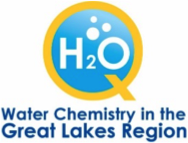H2O Q in the classroom
 H2O Q is a hands-on environmental education program that engages classrooms, community groups, industry professionals, and CMU students in testing water quality across the Great Lakes region. Using a simple kit developed by the American Chemical Society Midland Local Section, participants measure key water chemistry parameters and contribute their findings to a shared online map (database). H2O Q empowers students, educators, and community members to explore real-world environmental questions, compare data across regions, and take an active role in protecting local watersheds.
H2O Q is a hands-on environmental education program that engages classrooms, community groups, industry professionals, and CMU students in testing water quality across the Great Lakes region. Using a simple kit developed by the American Chemical Society Midland Local Section, participants measure key water chemistry parameters and contribute their findings to a shared online map (database). H2O Q empowers students, educators, and community members to explore real-world environmental questions, compare data across regions, and take an active role in protecting local watersheds.
Conduct the experiment
Use the American Chemical Society Midland Local Section H2O Q kit to measure seven key water quality parameters in your local watershed:
- Turbidity
- PH
- Conductivity
- Dissolved Oxygen
- Nitrogen
- Phosphate
- Alkalinity
Contribute to the community science ArcGIS map of data
Become part of a growing network of student scientists, and educatorsworking together to monitor and protect our region’s water. Afterconducting your water quality tests, you'll upload your results to thecrowdsourced ArcGIS water quality map, a dynamic, interactive tool thatcompiles data from participants all around the Great Lakes.
By contributing your findings, you’re not only adding to a valuable regional database, but also learning how data can drive real scientific discovery. This shared map allows you to compare your local results with other schools and teams, identify patterns or concerns, and even spark local environmental action. Your data becomes part of a broader conversation about water quality, climate impacts, and human influence bringing science to life in a meaningful and collaborative way.
Research your local water quality question and get involved
H2O Q encourages participants to go beyond testing and to think critically, ask questions, and take action. After collecting water quality data, students and community members are empowered to investigate local environmental issues that matter to them.
What factors are influencing nitrate levels in your local stream? Why is turbidity higher in one location than another? How does nearby land use affect water chemistry? These are the kinds of authentic, place-based questions that drive meaningful science, and H2O Q provides the tools to explore them.
Once your team has gathered and analyzed data, consider how you can make a difference locally. Get your classroom, nonprofit, or research group involved in identifying solutions and next steps. Whether it’s presenting findings to a local council, creating awareness campaigns, or partnering with a local watershed group, there are many ways to turn learning into action.
Looking for more ways to help? You can find or start a local stewardship project, from planting native vegetation along waterways to organizing stream cleanups, to directly contribute to improving water quality and protecting the health of our Great Lakes for future generations.
The CERM 2019 STEM team designed NGSS aligned environmental water quality chemistry activities for middle and high school students. The activities cover STEM NGSS (Next Generation Science Standards) categories and integrate categories outside of science to provide in-classroom teachers with a robust and fully implementable program. This novel project design leverages the scientific expertise of ACS professionals, providing their STEM expertise at an appropriate science level for everyone involved. The environmental science at the core of this STEM experience is time relevant, an affordable opportunity to perform real science, and helps create a regional community of next generation scientists.
Environmental science encompasses all STEM disciplines and helps students see real science outside their window. Experiencing the chemistry of this vast field will equip the students with the problem-solving tools to work through challenges. The analysis of key markers in the environment (P, N, turbidity, pH, temperature, etc.) incorporates multiple chemistry concepts and materials. By exploring these, students collect data that they in turn can crowd source to their colleagues. Comparing data from around the region, classrooms evaluate how their results compare to others, the source of the variation, and the impact on their local environment.